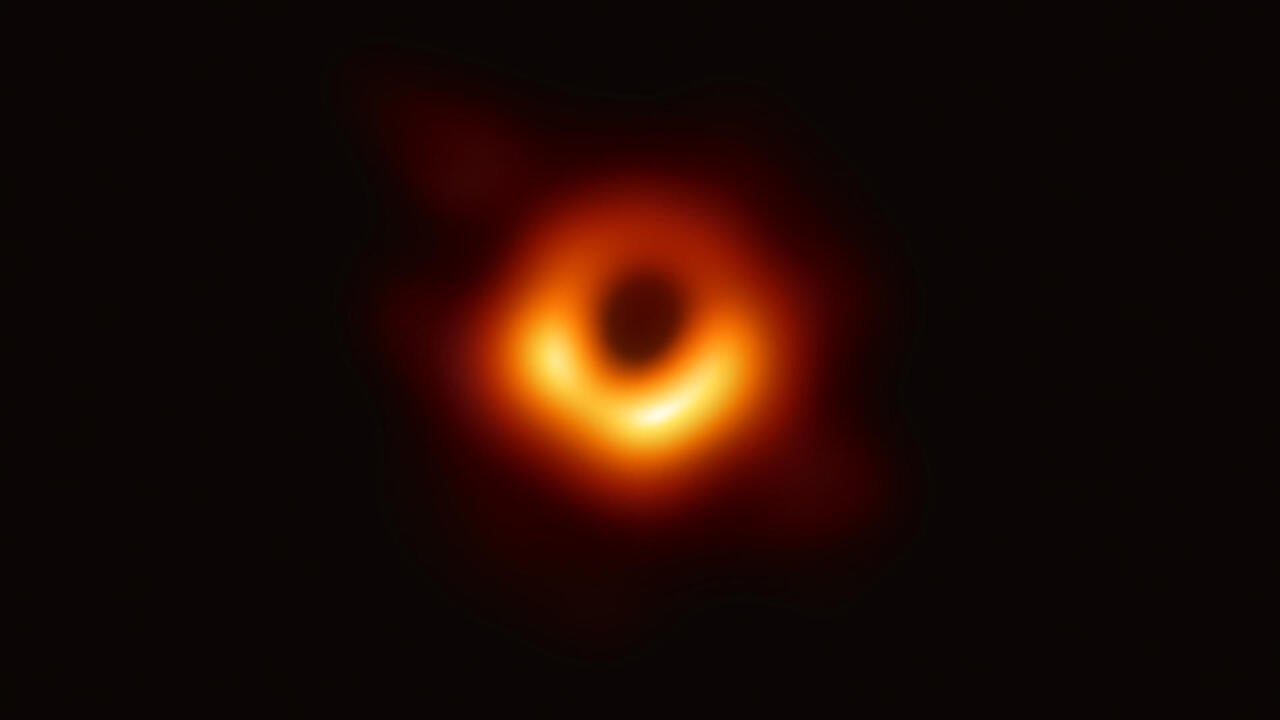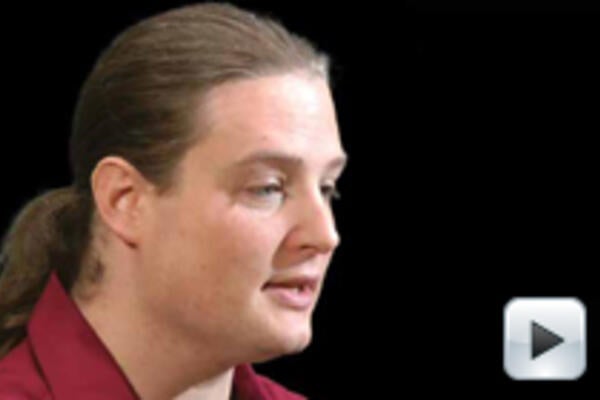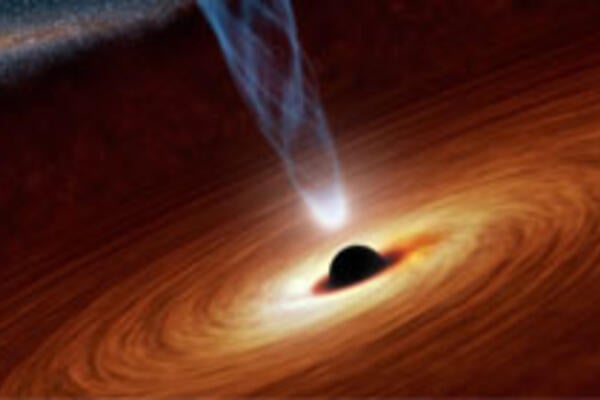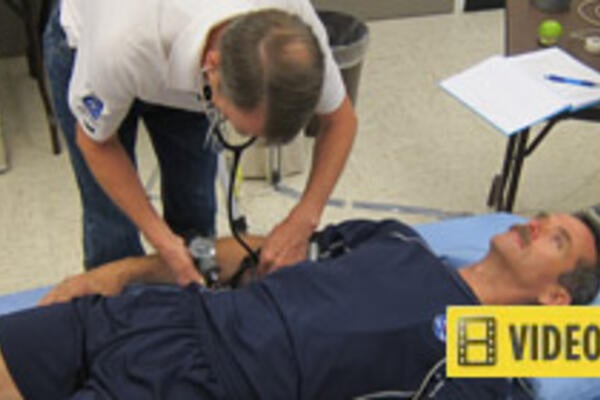
New analysis shows a “wobble” in the ring around a black hole
Avery Broderick talks about the latest Event Horizon Telescope work

Avery Broderick talks about the latest Event Horizon Telescope work
By Rose Simone Faculty of ScienceWhen the first picture of a black hole, a gravitational well from which no light can escape, was unveiled last year, it was a stunning technological feat.
That now-famous image of the black hole known as M87* which is 55 million light years away in the Messier 87 galaxy, was the result of over a decade of work by hundreds of scientists and engineers who are part of the Event Horizon Telescope (EHT) collaboration that created an “earth-sized” telescope out of eight telescope facilities around the world.
Yet the culmination of all that work was just the beginning.
Since then, the collaboration has been moving from black hole portraiture to black hole cinema.
In the most recent work, scientists used the older, archival data sets from observations of M87* that date all the way back to 2009, when there were only three telescope sites in the collaboration.
From that older data, combined with what they learned from the more recent observations, scientists constructed a moving image showing the “wobble” in the orientation of the bright crescent ring of plasma around M87* They are seeing the changes over time as the plasma is pushed and pulled by magnetic and gravitational forces in an extremely turbulent environment.
The work was published in The Astrophysical Journal in September.
 Avery Broderick
Avery Broderick
Professor, Faculty of Science
> Perimeter Institute for Theoretical Physics
We recently interviewed Avery Broderick, a professor at the University of Waterloo and an associate faculty member at Perimeter Institute for Theoretical Physics who has been a member of the EHT collaboration from the very beginning, about the latest work and what is in store for the future:
Broderick: By 2017, the Event Horizon Telescope had enough telescope stations around the earth to make the first complete images.
But that was not the first time we'd run the experiment. In fact, we had a lot of confidence that it would work because we had been running these experiments for a decade prior.
The first version of what would eventually become the Event Horizon telescope observed the black hole at center of our own galaxy in 2007. There were not enough stations back then to make an image, but from those observations we knew there was an image that could be made.
In 2009, we began doing the same for M87*, and we executed observations periodically in the years after that. None of those observations on their own provided enough information to yield an image, but if you know what you're looking for, you don’t need all the information.
I use the example of a picture of my daughter, Anna, who had a nice yellow ensemble when she was younger. Sometimes we would tease her and call her Anna Banana. So, you can ask, how many pixels would you need to be able to know whether you are looking at a picture of Anna or a picture of a banana? Even if she's wearing her yellow outfit, the answer is not that many. You can figure it out pretty fast.
The same is true of astronomical objects. We now know that M87* is well-described by this ring-like asymmetric-structure that is like a doughnut brightened on one side. If we know it looks like that, then we can use the past data to figure out how it was oriented, and how large it was, going back to previous years.
That is what this new paper is about. It is figuring out how to take all that legacy data and apply that to what we now know to be the truth, to help us understand how this structure might evolve in time.
Q: Is this like an animation then?
Broderick: It’s more like going through family photographs in an album and seeing how my daughter has grown. What she looked like when she was three and then five, etc.
So, we now have this beautiful high-resolution image of M87* from the observations in 2017, but by going back over the earlier data, we can see how it changed from year to year.
We are watching how that hairstyle evolved from one decade to the next, as it were.
Q: When they put all of this together, scientists see what is described as a “wobble.” But what is this wobble? What’s wobbling?
Broderick: You could ask, if we are looking at a black hole, how is it that we see anything at all?
Black holes are, after all, supposed to be black like the night sky. But they also turn out to be some of the brightest objects in the universe because so often black holes are not found in isolation. They're found in the company of stuff that is falling on the black hole, and as it does, it heats up and shines.
What we are really making pictures of is this bright plasma that surrounds the event horizon.
This plasma is very turbulent and it changes over time. All of our best calculations indicate that it isn’t a static, constant flow. Rather, it is a turbulent flow that is rushing headlong and creating absolute cacophony of light around the black hole.
What we are seeing here is these excursions in the plasma from side to side. That’s the wobble.
We can ask, given the models that we have for how turbulent plasmas around black holes work, how will this plasma around M87* behave from year to year? Does that comport with the size of the variations that we see? And the answer is yes. We're beginning to nail down some statement – not quite a movie but at least some statement — about how it changes.
Q: Was this wobble a surprise? Was it what you expected?
Broderick: The only surprise was how successful we were in being able to do this with the data that we had from the past. That really is a tour de force of both the analysis tools and the dedication of the people involved.
We did expect to see this kind of motion, and in fact this is something we think is critical to how material falls down into the black hole. The turbulent nature is not just incidental, but is required to drive material in.
We never worry too much about the Earth falling into the Sun, for example, because of angular momentum conservation. But were the Earth to strongly interact with other bodies that could provide torques on the Earth’s orbit, e.g., nearby planets or a proto-planetary disk present in the early life of the solar system, then we might worry about that.
Around black holes, there are magnetic interactions, not just gravitational interactions, that are critical in driving material in and out. These develop into a chaotic, frothing accretion flow. So, this turbulence is a key feature that we expected. It's nice to see it confirmed.
Q: What can you learn from this? What knowledge does it add?
Broderick: One conclusion from the study is that this turbulent picture continues to look like it's the right picture.
It's important for people to recognize that we are really at the very beginning of an incredible period of observational black hole astronomy.
When I was a graduate student, the idea of actually seeing these things was simply science fiction. The study of black holes was done on blackboards and we would come up with mathematical models and theories for how these objects behaved.
But no matter how well-informed the hypothesis is, what really matters is what the experiments say; many beautiful ideas in science have turned out to be simply wrong.
So here we are checking. I think this is the first resolved study that demonstrates that, in fact, this turbulent picture is the correct one. The observations from the EHT collaboration are laying the foundation under the house that theory built for black hole astrophysics. That makes this an extremely exciting time.
Q: How long have you been involved in this collaboration?
Broderick: Since before it even had a name. I've been doing this for two decades.
They don't let me touch the telescopes, or at least they're advised not to. My role in the collaboration is building models that make predictions for what we’re going to see, and trying to assess what it means when we have seen something.
Q: How is your team at Waterloo involved in the most recent work to show the wobble?
Broderick: What we do is develop the pipelines that go all the way from the pre-imaging data to the conclusions about the fundamental science questions that have driven the project and keep us all up at night.
Another way of saying it is that our job is to bring the actual detailed observables of the Event Horizon Telescope into direct contact with the science questions that drove its construction.
Towards that end, we've developed a large amount of software, we've developed a large number of models that facilitate this comparison, and then we execute them.
This wobble paper, was enabled by that process. Once we develop the software, we shared it with the collaboration. Members of the collaboration then got the idea to go and build out this set of analyses of this prior data given what we know now. We're very pleased that they're using the tools we’ve built here in Waterloo and we're very proud that it has succeeded so widely,
A key feature of this toolkit is careful error estimation. It is especially important to be able to assess how well we can make quantitative statements about the size and orientation of the bright ring in this context. This allows us to extract cutting edge science even when our data volume is very small and our data is incomplete. The software tools, the analysis tools we developed, are really enabling technologies for this kind of historical inspection where the data quality is poor.
Q: What is next for the EHT collaboration?
Broderick: The M87* results that we published a year ago this past April were very much just the first.
There are many more things we would like to know about how M87* changes. We want to look at the polarization, which tells us something about the magnetic fields. If the ring that we see is the color of the hairstyle, the magnetic fields might be the shape of the hairstyle.
That’s important for our understanding of how these black holes launch the relativistic jets that we see coming from M87*. We can see these jets that are flung out at nearly light speed from the black hole. How does that happen? That's something that astrophysicists have been talking about for many decades now, and here, we're finally able to start getting empirical answers.
But also, M87* is just one of the targets for the EHT collaboration. We are working very hard at making images, if not movies, of the supermassive black hole at the center of our own galaxy, Sgr A*. (abbreviation for Sagittarius A-Star).
Q: That must be exciting for you. You are seeing the fruits of a very long collaboration.
Broderick: It's an extraordinary feeling. That's right. One of the things that is funny is that now I'm an old man of the collaboration. I look at all the young postdocs and students working on this and they might lament about the data or about some aspect of the process, but I can say, "Well, look here, back when I was young, let me tell you how it was for us. You have eight stations, we had three!"
Q: For this Zoom meeting, there is a background image of the bridge of the Starship Enterprise behind you. You have spoken in the past about the show Star Trek inspired you to explore the universe. So the exploration continues!
Broderick: Yes, one day we might go around in the starships like this. But for now, I explore with telescopes and computers.

Read more
As a member of the Event Horizon Telescope team, Avery Broderick is helping to unravel the mysterious nature and behaviour of black holes, from the properties of the "event horizon" to how some can launch the energetic jets of matter and radiation that shape their host galaxies.

Read more
Waterloo scientist is part of team directing next-generation Japanese x-ray space observatory

Read more
Researcher in Applied Health Sciences is leading a new experiment aboard the International Space Station
The University of Waterloo acknowledges that much of our work takes place on the traditional territory of the Neutral, Anishinaabeg and Haudenosaunee peoples. Our main campus is situated on the Haldimand Tract, the land granted to the Six Nations that includes six miles on each side of the Grand River. Our active work toward reconciliation takes place across our campuses through research, learning, teaching, and community building, and is co-ordinated within the Office of Indigenous Relations.